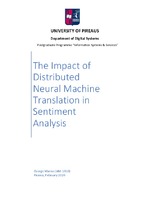The impact of distributed neural machine translation in sentiment analysis

View/
Keywords
Sentiment analysis ; Neural machine translation ; Natural language processing ; Multilingual sentiment analysis ; Deep learning ; Deep neural networks ; Convolutional neural networks ; Recurrent neural networksAbstract
In recent years there has been a steady increase in the interest of the research and business community in the field of Artificial Intelligence (AI). The ability of modern user devices to implement and apply highly sophisticated Machine Learning techniques has increased the importance of using and developing applications that will use Machine Learning techniques and algorithms to process and analyze user data.
Undoubtedly, progress in making computer systems more human-friendly requires the inclusion of Natural Language as an integral means of a wider communication interface. Nowadays, the overarching goal of natural language research is to enable communication between humans and computers without resorting to memorable and complex processes.
Modern chatbots, automatic translation engines, search engines and more are included in these applications. These applications implement algorithms and techniques in the field of Natural Language Processing (NLP), which is also a subtask of Machine Learning. It is one of the most evolving research and business areas of Machine Learning. While Natural Language Processing is not a new field of research, however, the explosion of technology and the need for more effective human-machine communication and understanding as well as the increased availability of big data, powerful computers and enhanced algorithms has led the last five years to the increasing of interest in the production of new algorithms and applications that will bring humans closer to the machines.
Natural Language Processing is widely used in the development of sophisticated user interfaces, as we can see in the multitude of modern mobile and web applications, bypassing the classic keyboard-mouse-screen model. In such an environment, the efficiency and speed of applications are significantly increased as it becomes more user-friendly, while new possibilities such as voice telephony interconnection are constantly being opened.
Natural Language Processing helps computers communicate with people, thereby increasing efficiency in tasks involving the use of written or oral speech. For example, NLP enables computers to read text, recognize speech, interpret, measure sentiment, and determine which parts of written or oral speech are most important to proceed with Q&A creating specific proposals.
Nowadays machines can analyze more human-based language data at no particular cost and in a coherent, non-discriminatory way. Given the staggering and ever-increasing amount of unwanted data generated daily from medical records to social media, automating their processing will be critical to effective data and speech analysis.
The continued interest of the scientific and business community in analyzing application users' sentiment has led to an increase in the search for satisfactory techniques and algorithms that will help users deliver services more effectively and efficiently. The research community has effectively proposed and developed methods for identifying and categorizing users' suggestions and feelings as expressed in a variety of different types of texts, such as blogs, reviews, tweets, and more.
But the needs and trends of modern intercultural and multilingual societies are increasingly demonstrating the need to create multilingual solutions and applications that will operate in a wider context and make full and effective use of the techniques of Machine Translation. Despite advances in the recognition of emotion in individual high-frequency and use languages, such as English, few applications and studies have been performed in less used and more difficult languages, Greek, and even less has been done on how to mechanically translate a text, from a smaller use language (Greek) to a more widely used language (English). Mistaken or with errors translation can result in falsification of the categorization of this text and the discovery of emotion through it. Many companies, giants e.g. TripAdvisor, Facebook, Google, NetFlix etc. focus their products and services in this direction. Recent years research teams of these companies try to implement and provide state-of-the-art machine translation systems. But is the translation result always correct, for example a critic in a movie and the sentiment that is derived from that particular translation over the original text? Can - and to what extent - the discovery of emotionality be falsified if we proceed to the Machine Translation of a text?
The purpose of this thesis is to investigate the impact of Neural Machine Translation on Sentiment Analysis by applying deep learning techniques such as Deep Neural Networks and multilingual sensing analysis tools. Recent advancements in the field of Neural Machine Translation enhance an interest of its use in Sentiment Analysis. A comparative analysis of different approaches and Neural Machine Translation open source services for multilingual sentiment analysis will be examined. These approaches are divided into two parts: one using classification of text without language translation and second using the translation of our analyzed data to a target language, such as Greek and German, before performing Text Classification and Sentiment Analysis.

